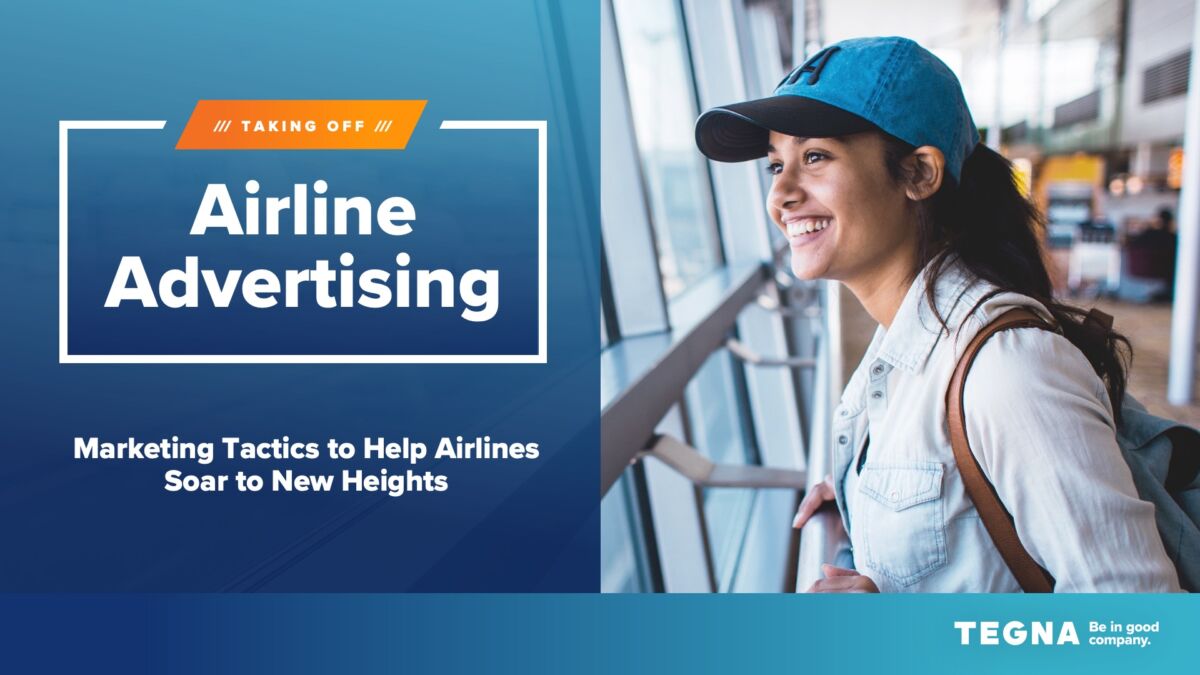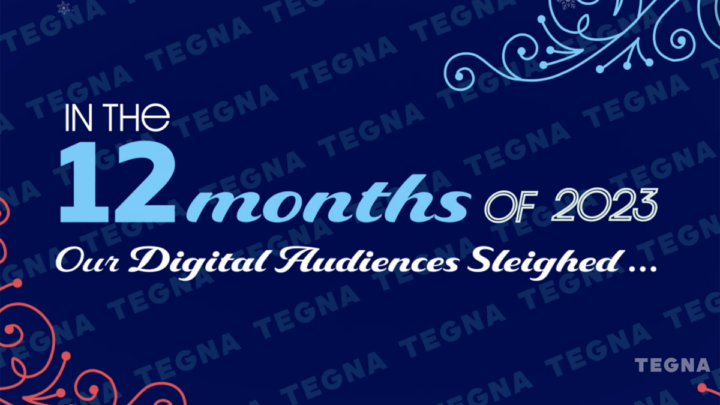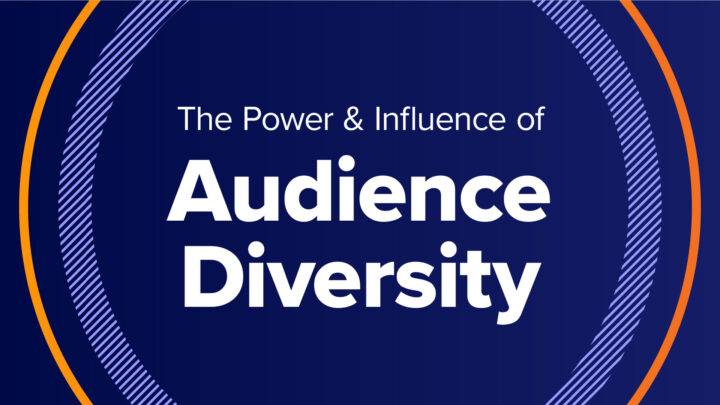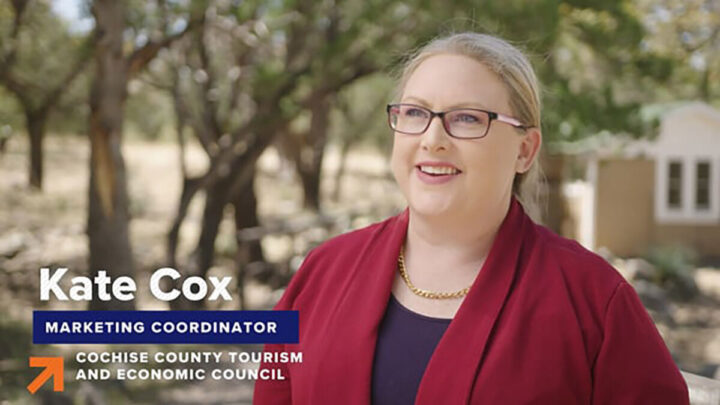Soar to New Heights: Airline Advertising Tactics
As an airline marketer, you’re seeking innovative ways to capture the hearts, minds, and wallets of today’s travelers. Amid a handful of new challenges brought forward in the past few years, the landscape is changing, and it’s crucial to reconsider your marketing’s angle of attack to stay fresh, relevant, and top of mind in a competitive environment.

We know that quality insights and fresh data give your brand an advantage in the marketplace, so we partnered with Provoke Insights for an all-new e-book, “Taking Off: Understanding Today’s Leisure Traveler.” Like our successful and award-winning auto e-book, millennial whitepaper, and healthcare study, we analyze consumer sentiments, motivators, and more to create actionable brand recommendations. Here’s what your airline needs to know to elevate your brand and attract travelers in today’s competitive market.
An Overview of Airline Advertising
With the skies filled with numerous options and travelers seeking the best deals and experiences, airline advertising has become a crucial tool in the industry.
Airline advertising refers to the strategies and promotional efforts employed by airlines to attract passengers, build brand awareness, and ultimately drive bookings. It encompasses a wide range of marketing activities, both online and offline, aimed at reaching and engaging potential travelers. From TV commercials to social media campaigns, from loyalty programs to email newsletters, airline advertising takes many forms.
The Current Landscape
To understand the significance of airline advertising, it’s essential to look at the numbers and the consumer mindset today. “Taking Off: Understanding Today’s Leisure Traveler” found:
Travel is Important for Consumers
Americans are prioritizing travel over the upcoming year, with many noting how important it has become post-pandemic. Consider the following numbers:
- 2 in 5 consider travel as more important today compared to pre-2020.
- 94% of Americans are planning leisure travel in the next 12 months
- 7 in 10 perceive travel as the highlight of their year
- 4 is the average number of overnight trips planned per person in the next 12 months
Inflation Remains a Big Challenge
Despite the importance of travel for Americans, inflation remains an obstacle. These higher costs are not necessarily dissuading people from taking vacations but may influence where they go and what they do.
- Staycations are becoming more popular, and consumers are increasingly looking for a good deal.
- 3 in 5 are swayed by deals and discounts when booking travel
- 1 in 3 Americans are changing their travel plans and staying close to home in response to inflationary pressures
Online Booking Trends
A Statista report reveals that in 2021, 44.7% of air travelers booked their flights online. “Taking Off: Understanding Today’s Leisure Traveler” finds that 62% of respondents are booking directly with airlines to access benefits like loyalty perks and special offers to avoid extra fees charged by third parties.
What Makes an Airline Stand Out?
Effective airline advertising can be the key to attracting passengers, building brand loyalty, and creating a lasting impact in the hearts and minds of travelers. Whether through creative marketing, loyalty programs, or memorable in-flight experiences, airlines that excel in advertising can set themselves apart and soar to new heights in the aviation industry.
Strong Creative
Crafting the perfect creative for your ad campaign can be a challenging task. How do you know what your target audience wants to see? We uncovered some insights straight from the sightseers, tourists, passengers, visitors, and globetrotters themselves. Themes include:
- Cinematic Escapism: The day-to-day is stressful, and we all deserve time to cut out the noise, escape reality for a few minutes, and relax. It should be no surprise that viewers want to see commercial creative appeal to this sentiment.
- Realism: Everyone dreams of an all-inclusive getaway at a luxury resort, but it’s not a realistic possibility for all, especially with the inflation concerns uncovered in our e-book. Therefore, some consumers want to see more affordable ads closer to home and less crowded than big, main event attractions and destinations.
- Details to Spark the Planning: Those with wanderlust want to rest and relax, including enjoying an easy booking process. Ads with planning details embedded within the creative will resonate with today’s travelers.
Customer Experience
Top-notch service is always expected, but a significant number of travelers believe that levels of service and staffing have declined in the past few years. Conversely, travelers rated cleanliness and cancellation policies as much improved. Offering top-notch customer service and cleanliness are cornerstones of the travel and tourism industry. More than ever, travel intenders rely on reviews to drive their decision-making. By utilizing honest reviews and testimonials in messaging, your brand can showcase specific ways you exceed expectations, assuaging concerns around declining service levels. You’ll also want to consider …
- Loyalty Programs to encourage repeat business by offering passengers incentives, rewards, and a sense of belonging.
- In-Flight Amenities: From spacious seating to gourmet meals and entertainment options, in-flight amenities play a significant role in attracting and retaining passengers.
Why is Airline Advertising Important?
Airline advertising is essential for several reasons, as it serves various purposes that benefit both airlines and their customers. For advertisers, it also helps with:
- Brand Visibility: Effective advertising increases an airline’s brand visibility, making it more likely for travelers to consider them when booking.
- Information Dissemination: Airlines use advertising to inform travelers about their services, special promotions, and offerings.
- Adaptation: Advertising helps airlines adapt to changing market conditions, respond to competitors, and navigate challenges such as the recent global health crisis.
Advertising Opportunities and Channels for Airlines
Based on our travel survey, 83% of consumers actively engage with travel-related content; 79% of respondents find travel videos engaging; 66% rely on such videos to aid their vacation planning; and 60% appreciate staying up-to-date with the latest travel trends through video.
These insights underline the indispensable role video content plays in your marketing and advertising strategy. Immersing viewers in high-quality visuals and videos can leave a lasting impression, igniting their imagination and fostering a genuine connection with your destination. You can harness the power of visually captivating video content to showcase your brand’s overall experience on the following platforms:
TV Advertising
TV advertising is an effective tool for broadcasting promotional messages, commercials, and other long-form content and content sponsorships to reach a broad and diverse audience and create brand awareness. TV ads also motivate consumers to research a product or service online and are the most influential medium in purchasing decisions.
Streaming
All the benefits of traditional TV also come with CTV/OTT streaming. Not only are news, weather, and sports available on streaming (the most popular content on broadcast TV), but there are also handfuls of high-quality content for viewers to enjoy. The perfect complement to a linear TV strategy is streaming, which extends reach to a targeted audience, can leverage retargeting, and uses reporting data to measure and optimize campaigns with a tool like TEGNA Attribution.
Digital Advertising
People are glued to their devices for both work and play, so there’s no mistaking the power of digital advertising. Consider adding the following digital tactics into your marketing mix to maximize outreach and engagement.
- Clickable Digital Ads: This can include display ads, video, high-impact, interscrollers, and other ads to increase engagement and website traffic.
- Contextual Advertising: Targeted advertising that delivers relevant ads to users based on the content they are viewing and focuses on the immediate actions of the user’s online activity.
- Geofencing: A popular and effective way to turn local search traffic into foot traffic to a storefront or other specific location. Advertisers use GPS technology to draw virtual fences around particular areas, such as a storefront, that they want to target with ads, offers, and promotions. Once a prospect enters a geofenced area, they’ll be served with mobile ads from that advertiser. Ideally, that prospect will make their way through the funnel and eventually convert.
- Retargeting: If a viewer shows interest in a brand’s digital ad, the brand can go back and re-engage the user with the brand. Retargeting capabilities of digital campaigns increase engagement and conversions.
- Native Advertising: A form of paid advertising that blends seamlessly with the content and format of the platform where it appears. It is designed to look and feel like the surrounding non-promotional content, making it less disruptive and more engaging for the audience. Ads are also typically labeled as “sponsored” or “promoted” content to indicate that they are paid placements.
7 Tips for Airline Marketing Campaigns
To run successful airline marketing campaigns, consider the following tips:
1. Use TV to Showcase Your Airline’s Amenities
The data underscores the enduring importance and value of TV advertising due to its consistent and high return on investment (ROI) for advertisers. According to a report by CNBC’s Catalyst, major players like Google, Facebook, and Netflix allocated a substantial 60% of their marketing budgets to TV ads in the UK. This trend is mirrored in the United States and across the globe. The fact that these digital giants, who dominate our online world, are heavily investing in TV advertising is a compelling indicator for others to follow suit.
2. Leverage Local News Stations
“Understanding Today’s Leisure Traveler” found that tourists and travelers rely on local news stations to educate and inform them of nearby tourist activities (59%) and the latest travel trends (44%). The study also found that travel brands can benefit from the halo effect when they partner with local news organizations that have earned the trust of their viewers. Sales-friendly lifestyle programming can elevate your message with opportunities for on-location or long-form segments.
3. Highlight Travel Destinations with Video
In the captivating world of travel and tourism, video can invoke wanderlust because of its ability to leverage amazing visuals, showcase sound, and create emotional connections with viewers. Knowing consumers want to see cinematic escapism, realism, and details to spark planning, airlines can use video to show off popular destinations to engage a wide-ranging audience.
What are popular destinations? “Understanding Today’s Leisure Traveler” found the top 10 domestic destinations to be Florida, California, New York, Texas, Nevada, Colorado, Hawaii, and Arizona. The leading international destinations are Europe, the Caribbean, Mexico, and Canada.
4. Combine the Power of TV and Digital
For many advertisers, it comes down to choosing between broadcast TV and digital … but who’s to say that you have to choose one over the other? Instead, you should aim to use both digital and TV advertising together instead of choosing just one. As digital continues to prove its effectiveness and TV remains an advertising staple, weaving these strategies together into a multi-channel marketing program is a powerful way to improve your marketing results.
5. Use Contextual Advertising to Reach the Right People
Contextual advertising is a valuable digital complement to enhance the effectiveness of broadcast and streaming TV campaigns. While TV and streaming ads frequently rely on broad demographic targeting to reach a wide audience, contextual advertising enables more precise targeting and retargeting. This approach is not only cost-effective but also facilitates a unified messaging strategy across various platforms, thereby boosting brand awareness, enhancing ad recall, engaging users, and reinforcing messaging to viewers.
6. Focus on the Customer Experience
Although showing signs of cooling, 76% expect inflation to impact travel in the coming year. You’ll want to showcase deals, price points, loyalty, and rewards programs to entice viewers and frequent fliers to earn repeat business. Deloitte also found that these frequent fliers (both for business and leisure) are the least likely to shift airline brands based on a temporary deal and are most likely to recommend an airline to their social circle.
7. Create Targeted Campaigns
Not all travelers are the same. You’ll want to tailor each campaign to meet the needs of each audience segment. Creating persona profiles is an excellent idea to learn about your audience. As you gather research to complete these profiles, you’ll discover bits and pieces of information to inform your campaign better. For example, Deloitte also found that 68% of high-frequency business travelers see access to airport lounges as essential compared to only 40% of all survey respondents.
Help Travelers Get Away with TEGNA
At TEGNA, our ultimate goal is to equip brands with data and insights to inform and develop creative, then amplify those messages with cross-platform campaigns, including linear, streaming, and digital elements. With 64 broadcast stations in 51 markets nationwide, our unique content opportunities will connect your business to the audiences that matter most and deliver proven results. Let’s get in touch to see how we can help your brand grow with the power of TV advertising.
Frequently Asked Questions
How do airlines attract new customers?
Airlines that excel in advertising can set themselves apart and soar to new heights in the aviation industry. Airlines would be wise to leverage the power of video to showcase cinematic escapism, realism, and ideas to spark trip planning. Effective campaigns then use video through linear and streaming TV, digital channels, and partnerships with local broadcast news stations.
What have been the most successful marketing tools for airlines?
Successful marketing tools for airlines include television ads, digital advertising, loyalty programs, and strategic partnerships.
How do airlines use digital marketing?
Airlines use digital marketing for online advertising, email campaigns, social media engagement, and search engine optimization to reach a broader audience.
What drives airline demand?
Airline demand is driven by ticket prices, flight availability, destination appeal, customer experience, and loyalty programs. Passengers’ preferences vary, so airlines must consider various elements to attract travelers.






















